Analysis of Contract and Negligence in Business Law Context
VerifiedAdded on 2020/01/07
|17
|5762
|98
Report
AI Summary
This report provides a detailed analysis of contract and negligence law within a business context. It begins by identifying the essential legal elements required for a valid contract, including offer, acceptance, consideration, intention, certainty, and capacity, emphasizing their importance. The report then explores different types of contracts, such as bilateral, unilateral, void, voidable, and distance selling contracts, examining their impacts. Furthermore, it delves into the meaning and effect of contract terms, including express, implied terms, conditions, warranties, and exclusion clauses. The report also differentiates between tort and contractual liability, explaining negligence and vicarious liability. It analyzes scenarios applying contract principles and provides advice based on common law rules, evaluating the effect of exclusion clauses. Finally, it examines professional negligence misstatement and defenses, offering advice on pursuing negligence actions.
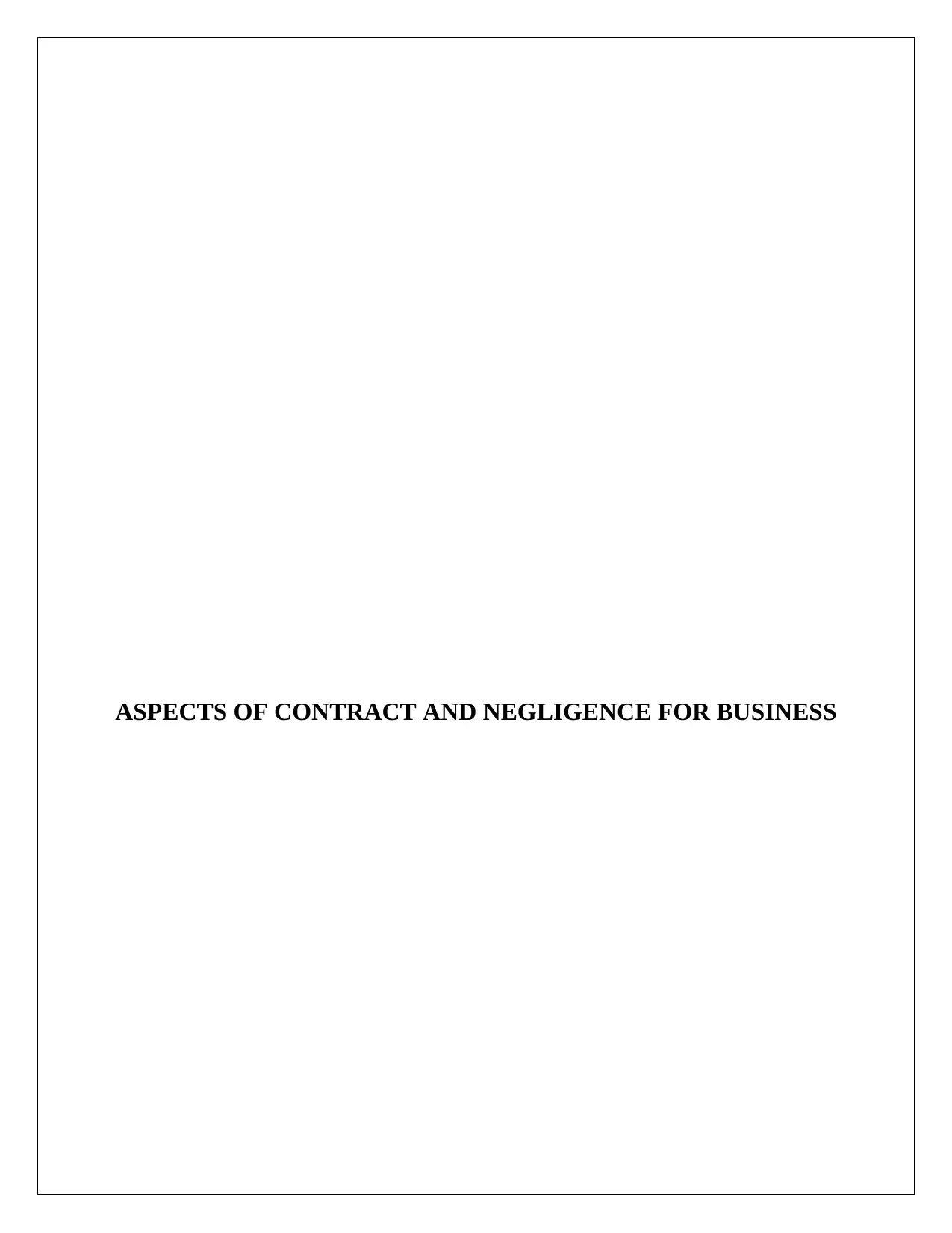
ASPECTS OF CONTRACT AND NEGLIGENCE FOR BUSINESS
Paraphrase This Document
Need a fresh take? Get an instant paraphrase of this document with our AI Paraphraser
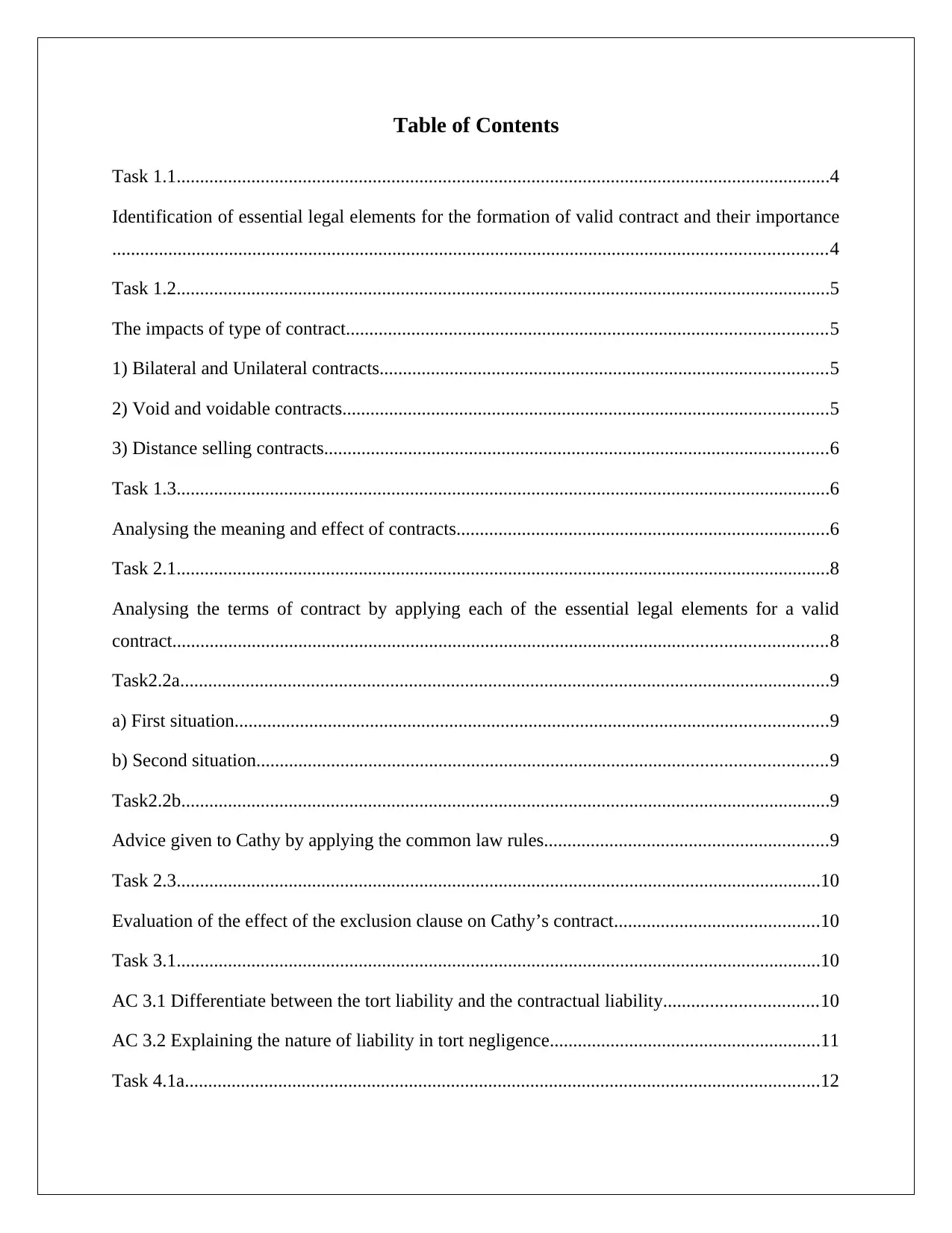
Table of Contents
Task 1.1............................................................................................................................................4
Identification of essential legal elements for the formation of valid contract and their importance
.........................................................................................................................................................4
Task 1.2............................................................................................................................................5
The impacts of type of contract.......................................................................................................5
1) Bilateral and Unilateral contracts................................................................................................5
2) Void and voidable contracts........................................................................................................5
3) Distance selling contracts............................................................................................................6
Task 1.3............................................................................................................................................6
Analysing the meaning and effect of contracts................................................................................6
Task 2.1............................................................................................................................................8
Analysing the terms of contract by applying each of the essential legal elements for a valid
contract............................................................................................................................................8
Task2.2a...........................................................................................................................................9
a) First situation...............................................................................................................................9
b) Second situation..........................................................................................................................9
Task2.2b...........................................................................................................................................9
Advice given to Cathy by applying the common law rules.............................................................9
Task 2.3..........................................................................................................................................10
Evaluation of the effect of the exclusion clause on Cathy’s contract............................................10
Task 3.1..........................................................................................................................................10
AC 3.1 Differentiate between the tort liability and the contractual liability.................................10
AC 3.2 Explaining the nature of liability in tort negligence..........................................................11
Task 4.1a........................................................................................................................................12
Task 1.1............................................................................................................................................4
Identification of essential legal elements for the formation of valid contract and their importance
.........................................................................................................................................................4
Task 1.2............................................................................................................................................5
The impacts of type of contract.......................................................................................................5
1) Bilateral and Unilateral contracts................................................................................................5
2) Void and voidable contracts........................................................................................................5
3) Distance selling contracts............................................................................................................6
Task 1.3............................................................................................................................................6
Analysing the meaning and effect of contracts................................................................................6
Task 2.1............................................................................................................................................8
Analysing the terms of contract by applying each of the essential legal elements for a valid
contract............................................................................................................................................8
Task2.2a...........................................................................................................................................9
a) First situation...............................................................................................................................9
b) Second situation..........................................................................................................................9
Task2.2b...........................................................................................................................................9
Advice given to Cathy by applying the common law rules.............................................................9
Task 2.3..........................................................................................................................................10
Evaluation of the effect of the exclusion clause on Cathy’s contract............................................10
Task 3.1..........................................................................................................................................10
AC 3.1 Differentiate between the tort liability and the contractual liability.................................10
AC 3.2 Explaining the nature of liability in tort negligence..........................................................11
Task 4.1a........................................................................................................................................12
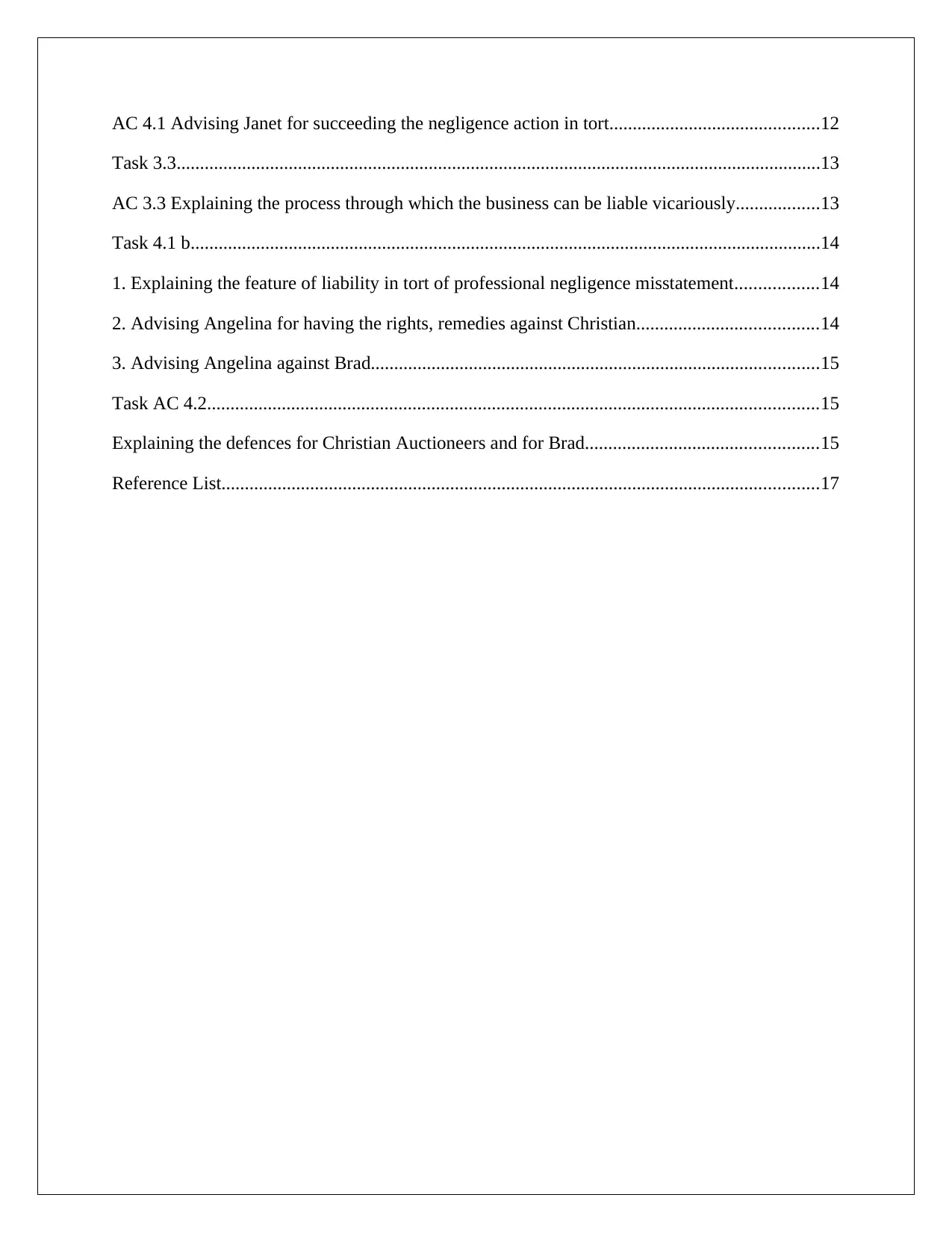
AC 4.1 Advising Janet for succeeding the negligence action in tort.............................................12
Task 3.3..........................................................................................................................................13
AC 3.3 Explaining the process through which the business can be liable vicariously..................13
Task 4.1 b.......................................................................................................................................14
1. Explaining the feature of liability in tort of professional negligence misstatement..................14
2. Advising Angelina for having the rights, remedies against Christian.......................................14
3. Advising Angelina against Brad................................................................................................15
Task AC 4.2...................................................................................................................................15
Explaining the defences for Christian Auctioneers and for Brad..................................................15
Reference List................................................................................................................................17
Task 3.3..........................................................................................................................................13
AC 3.3 Explaining the process through which the business can be liable vicariously..................13
Task 4.1 b.......................................................................................................................................14
1. Explaining the feature of liability in tort of professional negligence misstatement..................14
2. Advising Angelina for having the rights, remedies against Christian.......................................14
3. Advising Angelina against Brad................................................................................................15
Task AC 4.2...................................................................................................................................15
Explaining the defences for Christian Auctioneers and for Brad..................................................15
Reference List................................................................................................................................17
⊘ This is a preview!⊘
Do you want full access?
Subscribe today to unlock all pages.

Trusted by 1+ million students worldwide
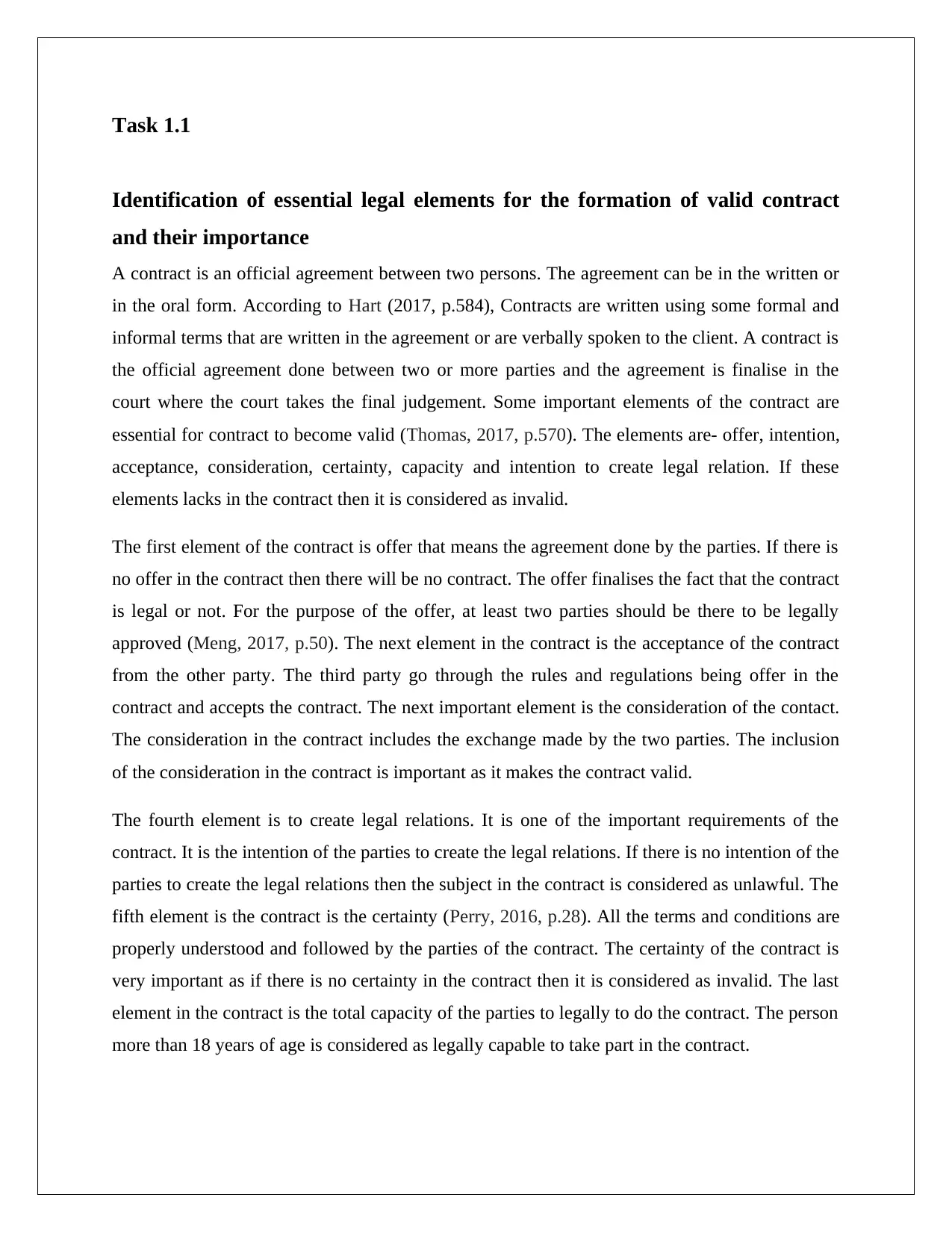
Task 1.1
Identification of essential legal elements for the formation of valid contract
and their importance
A contract is an official agreement between two persons. The agreement can be in the written or
in the oral form. According to Hart (2017, p.584), Contracts are written using some formal and
informal terms that are written in the agreement or are verbally spoken to the client. A contract is
the official agreement done between two or more parties and the agreement is finalise in the
court where the court takes the final judgement. Some important elements of the contract are
essential for contract to become valid (Thomas, 2017, p.570). The elements are- offer, intention,
acceptance, consideration, certainty, capacity and intention to create legal relation. If these
elements lacks in the contract then it is considered as invalid.
The first element of the contract is offer that means the agreement done by the parties. If there is
no offer in the contract then there will be no contract. The offer finalises the fact that the contract
is legal or not. For the purpose of the offer, at least two parties should be there to be legally
approved (Meng, 2017, p.50). The next element in the contract is the acceptance of the contract
from the other party. The third party go through the rules and regulations being offer in the
contract and accepts the contract. The next important element is the consideration of the contact.
The consideration in the contract includes the exchange made by the two parties. The inclusion
of the consideration in the contract is important as it makes the contract valid.
The fourth element is to create legal relations. It is one of the important requirements of the
contract. It is the intention of the parties to create the legal relations. If there is no intention of the
parties to create the legal relations then the subject in the contract is considered as unlawful. The
fifth element is the contract is the certainty (Perry, 2016, p.28). All the terms and conditions are
properly understood and followed by the parties of the contract. The certainty of the contract is
very important as if there is no certainty in the contract then it is considered as invalid. The last
element in the contract is the total capacity of the parties to legally to do the contract. The person
more than 18 years of age is considered as legally capable to take part in the contract.
Identification of essential legal elements for the formation of valid contract
and their importance
A contract is an official agreement between two persons. The agreement can be in the written or
in the oral form. According to Hart (2017, p.584), Contracts are written using some formal and
informal terms that are written in the agreement or are verbally spoken to the client. A contract is
the official agreement done between two or more parties and the agreement is finalise in the
court where the court takes the final judgement. Some important elements of the contract are
essential for contract to become valid (Thomas, 2017, p.570). The elements are- offer, intention,
acceptance, consideration, certainty, capacity and intention to create legal relation. If these
elements lacks in the contract then it is considered as invalid.
The first element of the contract is offer that means the agreement done by the parties. If there is
no offer in the contract then there will be no contract. The offer finalises the fact that the contract
is legal or not. For the purpose of the offer, at least two parties should be there to be legally
approved (Meng, 2017, p.50). The next element in the contract is the acceptance of the contract
from the other party. The third party go through the rules and regulations being offer in the
contract and accepts the contract. The next important element is the consideration of the contact.
The consideration in the contract includes the exchange made by the two parties. The inclusion
of the consideration in the contract is important as it makes the contract valid.
The fourth element is to create legal relations. It is one of the important requirements of the
contract. It is the intention of the parties to create the legal relations. If there is no intention of the
parties to create the legal relations then the subject in the contract is considered as unlawful. The
fifth element is the contract is the certainty (Perry, 2016, p.28). All the terms and conditions are
properly understood and followed by the parties of the contract. The certainty of the contract is
very important as if there is no certainty in the contract then it is considered as invalid. The last
element in the contract is the total capacity of the parties to legally to do the contract. The person
more than 18 years of age is considered as legally capable to take part in the contract.
Paraphrase This Document
Need a fresh take? Get an instant paraphrase of this document with our AI Paraphraser
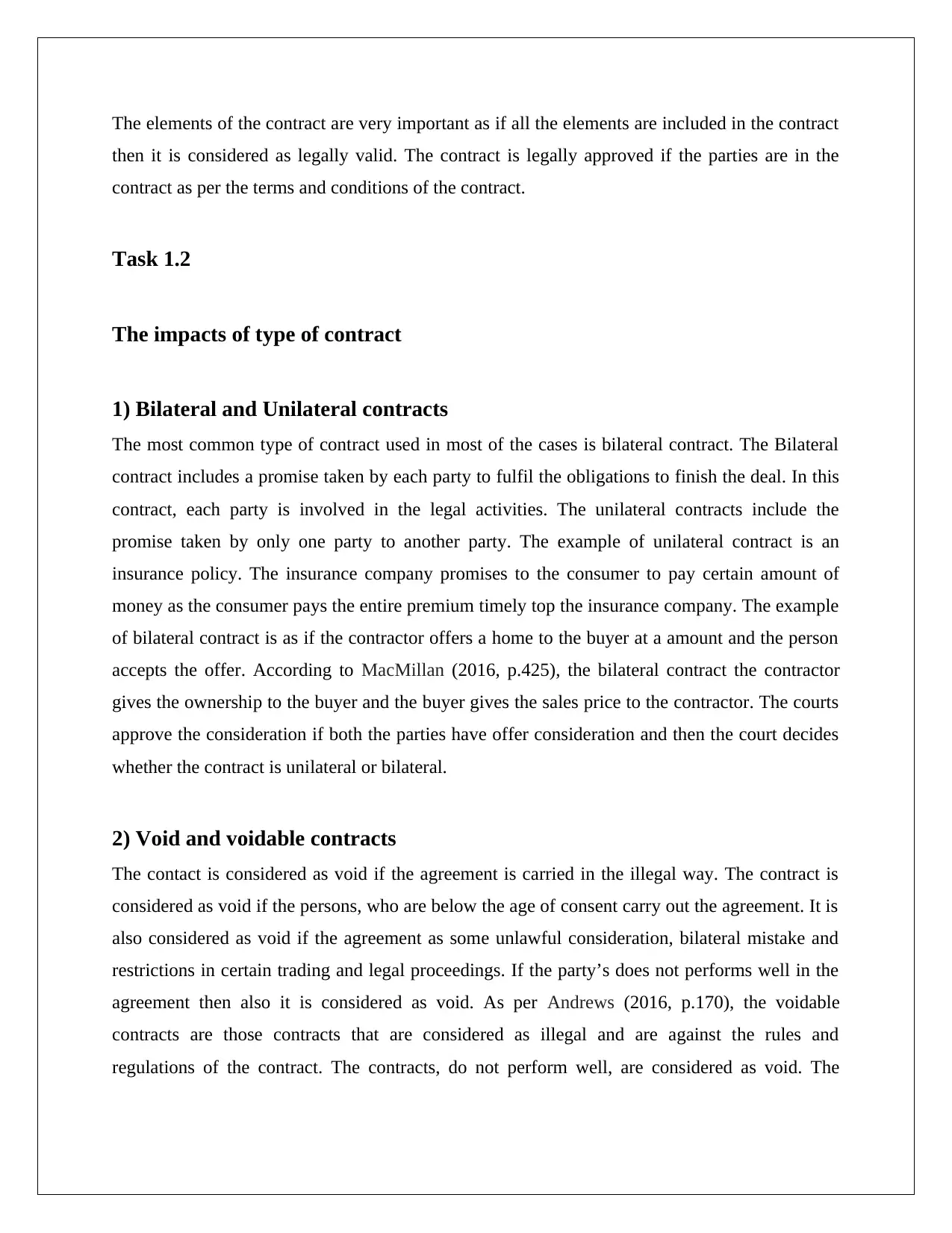
The elements of the contract are very important as if all the elements are included in the contract
then it is considered as legally valid. The contract is legally approved if the parties are in the
contract as per the terms and conditions of the contract.
Task 1.2
The impacts of type of contract
1) Bilateral and Unilateral contracts
The most common type of contract used in most of the cases is bilateral contract. The Bilateral
contract includes a promise taken by each party to fulfil the obligations to finish the deal. In this
contract, each party is involved in the legal activities. The unilateral contracts include the
promise taken by only one party to another party. The example of unilateral contract is an
insurance policy. The insurance company promises to the consumer to pay certain amount of
money as the consumer pays the entire premium timely top the insurance company. The example
of bilateral contract is as if the contractor offers a home to the buyer at a amount and the person
accepts the offer. According to MacMillan (2016, p.425), the bilateral contract the contractor
gives the ownership to the buyer and the buyer gives the sales price to the contractor. The courts
approve the consideration if both the parties have offer consideration and then the court decides
whether the contract is unilateral or bilateral.
2) Void and voidable contracts
The contact is considered as void if the agreement is carried in the illegal way. The contract is
considered as void if the persons, who are below the age of consent carry out the agreement. It is
also considered as void if the agreement as some unlawful consideration, bilateral mistake and
restrictions in certain trading and legal proceedings. If the party’s does not performs well in the
agreement then also it is considered as void. As per Andrews (2016, p.170), the voidable
contracts are those contracts that are considered as illegal and are against the rules and
regulations of the contract. The contracts, do not perform well, are considered as void. The
then it is considered as legally valid. The contract is legally approved if the parties are in the
contract as per the terms and conditions of the contract.
Task 1.2
The impacts of type of contract
1) Bilateral and Unilateral contracts
The most common type of contract used in most of the cases is bilateral contract. The Bilateral
contract includes a promise taken by each party to fulfil the obligations to finish the deal. In this
contract, each party is involved in the legal activities. The unilateral contracts include the
promise taken by only one party to another party. The example of unilateral contract is an
insurance policy. The insurance company promises to the consumer to pay certain amount of
money as the consumer pays the entire premium timely top the insurance company. The example
of bilateral contract is as if the contractor offers a home to the buyer at a amount and the person
accepts the offer. According to MacMillan (2016, p.425), the bilateral contract the contractor
gives the ownership to the buyer and the buyer gives the sales price to the contractor. The courts
approve the consideration if both the parties have offer consideration and then the court decides
whether the contract is unilateral or bilateral.
2) Void and voidable contracts
The contact is considered as void if the agreement is carried in the illegal way. The contract is
considered as void if the persons, who are below the age of consent carry out the agreement. It is
also considered as void if the agreement as some unlawful consideration, bilateral mistake and
restrictions in certain trading and legal proceedings. If the party’s does not performs well in the
agreement then also it is considered as void. As per Andrews (2016, p.170), the voidable
contracts are those contracts that are considered as illegal and are against the rules and
regulations of the contract. The contracts, do not perform well, are considered as void. The
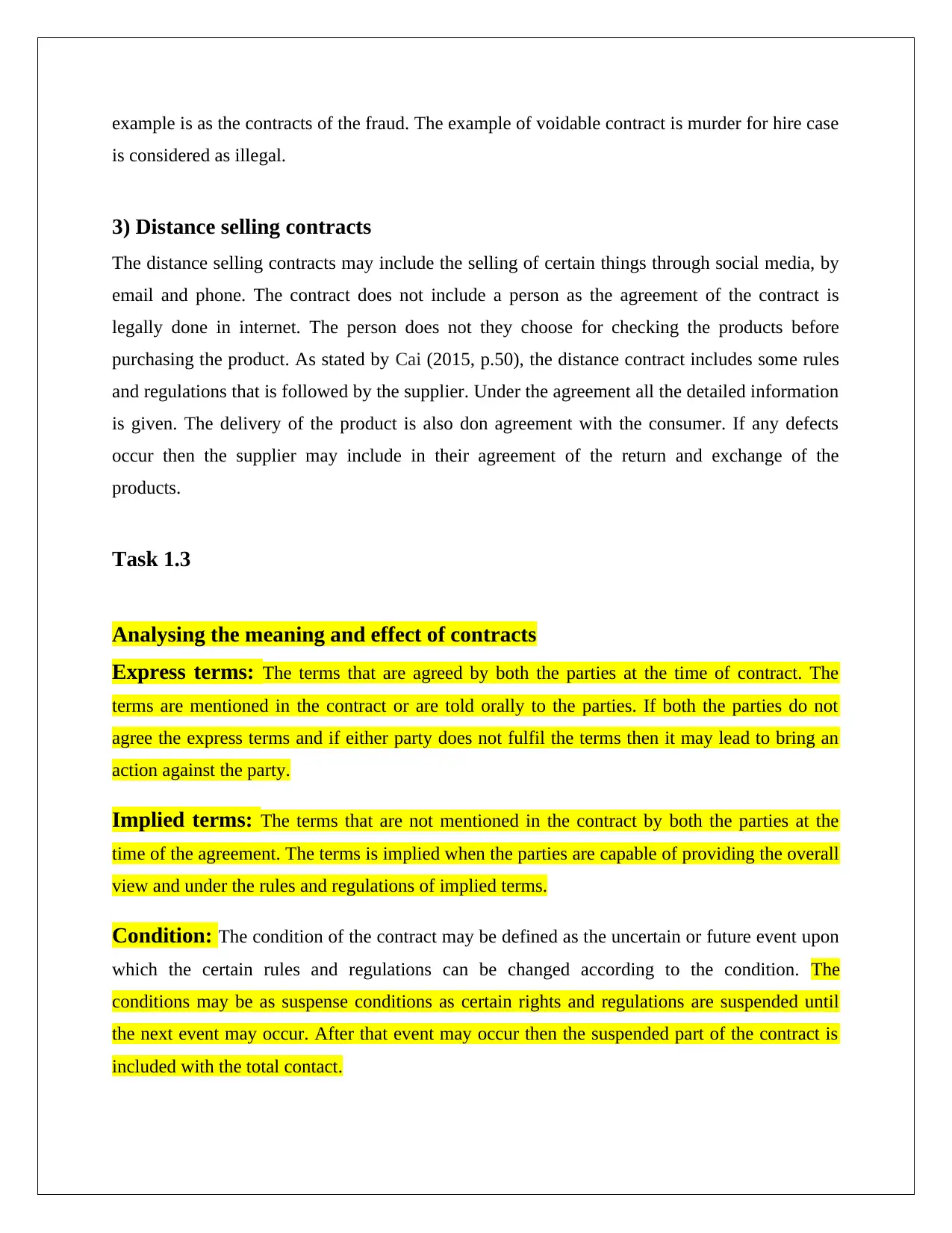
example is as the contracts of the fraud. The example of voidable contract is murder for hire case
is considered as illegal.
3) Distance selling contracts
The distance selling contracts may include the selling of certain things through social media, by
email and phone. The contract does not include a person as the agreement of the contract is
legally done in internet. The person does not they choose for checking the products before
purchasing the product. As stated by Cai (2015, p.50), the distance contract includes some rules
and regulations that is followed by the supplier. Under the agreement all the detailed information
is given. The delivery of the product is also don agreement with the consumer. If any defects
occur then the supplier may include in their agreement of the return and exchange of the
products.
Task 1.3
Analysing the meaning and effect of contracts
Express terms: The terms that are agreed by both the parties at the time of contract. The
terms are mentioned in the contract or are told orally to the parties. If both the parties do not
agree the express terms and if either party does not fulfil the terms then it may lead to bring an
action against the party.
Implied terms: The terms that are not mentioned in the contract by both the parties at the
time of the agreement. The terms is implied when the parties are capable of providing the overall
view and under the rules and regulations of implied terms.
Condition: The condition of the contract may be defined as the uncertain or future event upon
which the certain rules and regulations can be changed according to the condition. The
conditions may be as suspense conditions as certain rights and regulations are suspended until
the next event may occur. After that event may occur then the suspended part of the contract is
included with the total contact.
is considered as illegal.
3) Distance selling contracts
The distance selling contracts may include the selling of certain things through social media, by
email and phone. The contract does not include a person as the agreement of the contract is
legally done in internet. The person does not they choose for checking the products before
purchasing the product. As stated by Cai (2015, p.50), the distance contract includes some rules
and regulations that is followed by the supplier. Under the agreement all the detailed information
is given. The delivery of the product is also don agreement with the consumer. If any defects
occur then the supplier may include in their agreement of the return and exchange of the
products.
Task 1.3
Analysing the meaning and effect of contracts
Express terms: The terms that are agreed by both the parties at the time of contract. The
terms are mentioned in the contract or are told orally to the parties. If both the parties do not
agree the express terms and if either party does not fulfil the terms then it may lead to bring an
action against the party.
Implied terms: The terms that are not mentioned in the contract by both the parties at the
time of the agreement. The terms is implied when the parties are capable of providing the overall
view and under the rules and regulations of implied terms.
Condition: The condition of the contract may be defined as the uncertain or future event upon
which the certain rules and regulations can be changed according to the condition. The
conditions may be as suspense conditions as certain rights and regulations are suspended until
the next event may occur. After that event may occur then the suspended part of the contract is
included with the total contact.
⊘ This is a preview!⊘
Do you want full access?
Subscribe today to unlock all pages.

Trusted by 1+ million students worldwide
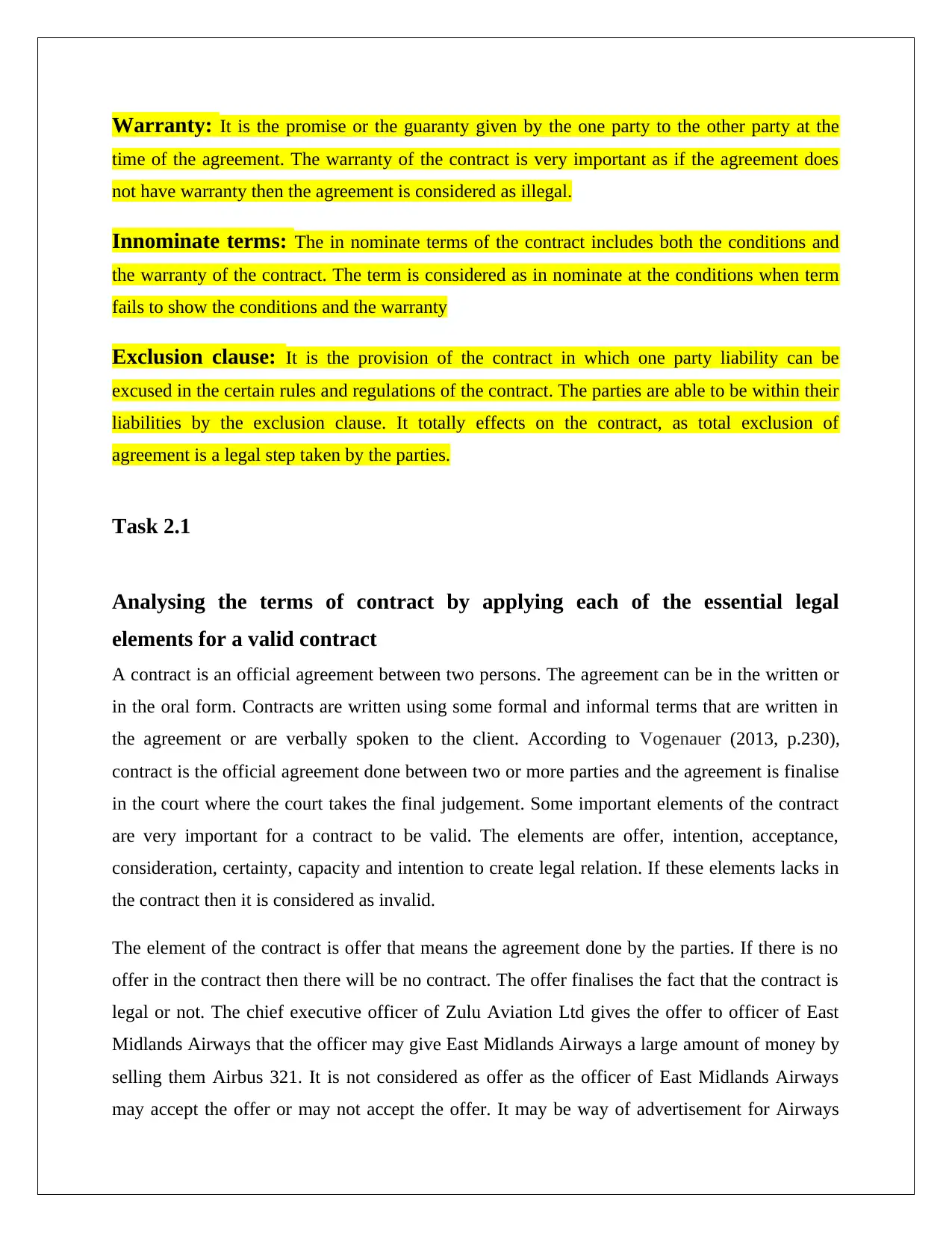
Warranty: It is the promise or the guaranty given by the one party to the other party at the
time of the agreement. The warranty of the contract is very important as if the agreement does
not have warranty then the agreement is considered as illegal.
Innominate terms: The in nominate terms of the contract includes both the conditions and
the warranty of the contract. The term is considered as in nominate at the conditions when term
fails to show the conditions and the warranty
Exclusion clause: It is the provision of the contract in which one party liability can be
excused in the certain rules and regulations of the contract. The parties are able to be within their
liabilities by the exclusion clause. It totally effects on the contract, as total exclusion of
agreement is a legal step taken by the parties.
Task 2.1
Analysing the terms of contract by applying each of the essential legal
elements for a valid contract
A contract is an official agreement between two persons. The agreement can be in the written or
in the oral form. Contracts are written using some formal and informal terms that are written in
the agreement or are verbally spoken to the client. According to Vogenauer (2013, p.230),
contract is the official agreement done between two or more parties and the agreement is finalise
in the court where the court takes the final judgement. Some important elements of the contract
are very important for a contract to be valid. The elements are offer, intention, acceptance,
consideration, certainty, capacity and intention to create legal relation. If these elements lacks in
the contract then it is considered as invalid.
The element of the contract is offer that means the agreement done by the parties. If there is no
offer in the contract then there will be no contract. The offer finalises the fact that the contract is
legal or not. The chief executive officer of Zulu Aviation Ltd gives the offer to officer of East
Midlands Airways that the officer may give East Midlands Airways a large amount of money by
selling them Airbus 321. It is not considered as offer as the officer of East Midlands Airways
may accept the offer or may not accept the offer. It may be way of advertisement for Airways
time of the agreement. The warranty of the contract is very important as if the agreement does
not have warranty then the agreement is considered as illegal.
Innominate terms: The in nominate terms of the contract includes both the conditions and
the warranty of the contract. The term is considered as in nominate at the conditions when term
fails to show the conditions and the warranty
Exclusion clause: It is the provision of the contract in which one party liability can be
excused in the certain rules and regulations of the contract. The parties are able to be within their
liabilities by the exclusion clause. It totally effects on the contract, as total exclusion of
agreement is a legal step taken by the parties.
Task 2.1
Analysing the terms of contract by applying each of the essential legal
elements for a valid contract
A contract is an official agreement between two persons. The agreement can be in the written or
in the oral form. Contracts are written using some formal and informal terms that are written in
the agreement or are verbally spoken to the client. According to Vogenauer (2013, p.230),
contract is the official agreement done between two or more parties and the agreement is finalise
in the court where the court takes the final judgement. Some important elements of the contract
are very important for a contract to be valid. The elements are offer, intention, acceptance,
consideration, certainty, capacity and intention to create legal relation. If these elements lacks in
the contract then it is considered as invalid.
The element of the contract is offer that means the agreement done by the parties. If there is no
offer in the contract then there will be no contract. The offer finalises the fact that the contract is
legal or not. The chief executive officer of Zulu Aviation Ltd gives the offer to officer of East
Midlands Airways that the officer may give East Midlands Airways a large amount of money by
selling them Airbus 321. It is not considered as offer as the officer of East Midlands Airways
may accept the offer or may not accept the offer. It may be way of advertisement for Airways
Paraphrase This Document
Need a fresh take? Get an instant paraphrase of this document with our AI Paraphraser
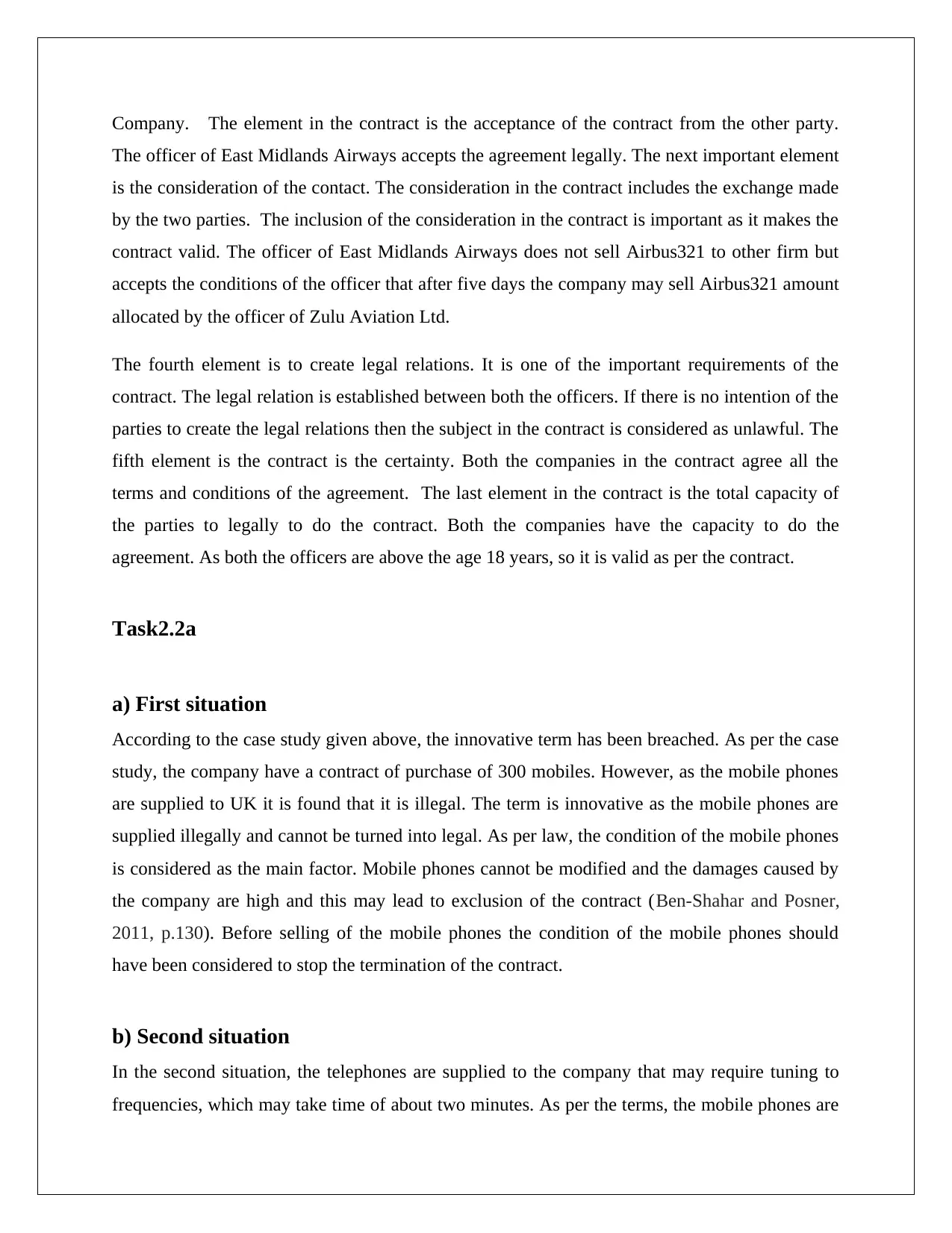
Company. The element in the contract is the acceptance of the contract from the other party.
The officer of East Midlands Airways accepts the agreement legally. The next important element
is the consideration of the contact. The consideration in the contract includes the exchange made
by the two parties. The inclusion of the consideration in the contract is important as it makes the
contract valid. The officer of East Midlands Airways does not sell Airbus321 to other firm but
accepts the conditions of the officer that after five days the company may sell Airbus321 amount
allocated by the officer of Zulu Aviation Ltd.
The fourth element is to create legal relations. It is one of the important requirements of the
contract. The legal relation is established between both the officers. If there is no intention of the
parties to create the legal relations then the subject in the contract is considered as unlawful. The
fifth element is the contract is the certainty. Both the companies in the contract agree all the
terms and conditions of the agreement. The last element in the contract is the total capacity of
the parties to legally to do the contract. Both the companies have the capacity to do the
agreement. As both the officers are above the age 18 years, so it is valid as per the contract.
Task2.2a
a) First situation
According to the case study given above, the innovative term has been breached. As per the case
study, the company have a contract of purchase of 300 mobiles. However, as the mobile phones
are supplied to UK it is found that it is illegal. The term is innovative as the mobile phones are
supplied illegally and cannot be turned into legal. As per law, the condition of the mobile phones
is considered as the main factor. Mobile phones cannot be modified and the damages caused by
the company are high and this may lead to exclusion of the contract (Ben-Shahar and Posner,
2011, p.130). Before selling of the mobile phones the condition of the mobile phones should
have been considered to stop the termination of the contract.
b) Second situation
In the second situation, the telephones are supplied to the company that may require tuning to
frequencies, which may take time of about two minutes. As per the terms, the mobile phones are
The officer of East Midlands Airways accepts the agreement legally. The next important element
is the consideration of the contact. The consideration in the contract includes the exchange made
by the two parties. The inclusion of the consideration in the contract is important as it makes the
contract valid. The officer of East Midlands Airways does not sell Airbus321 to other firm but
accepts the conditions of the officer that after five days the company may sell Airbus321 amount
allocated by the officer of Zulu Aviation Ltd.
The fourth element is to create legal relations. It is one of the important requirements of the
contract. The legal relation is established between both the officers. If there is no intention of the
parties to create the legal relations then the subject in the contract is considered as unlawful. The
fifth element is the contract is the certainty. Both the companies in the contract agree all the
terms and conditions of the agreement. The last element in the contract is the total capacity of
the parties to legally to do the contract. Both the companies have the capacity to do the
agreement. As both the officers are above the age 18 years, so it is valid as per the contract.
Task2.2a
a) First situation
According to the case study given above, the innovative term has been breached. As per the case
study, the company have a contract of purchase of 300 mobiles. However, as the mobile phones
are supplied to UK it is found that it is illegal. The term is innovative as the mobile phones are
supplied illegally and cannot be turned into legal. As per law, the condition of the mobile phones
is considered as the main factor. Mobile phones cannot be modified and the damages caused by
the company are high and this may lead to exclusion of the contract (Ben-Shahar and Posner,
2011, p.130). Before selling of the mobile phones the condition of the mobile phones should
have been considered to stop the termination of the contract.
b) Second situation
In the second situation, the telephones are supplied to the company that may require tuning to
frequencies, which may take time of about two minutes. As per the terms, the mobile phones are
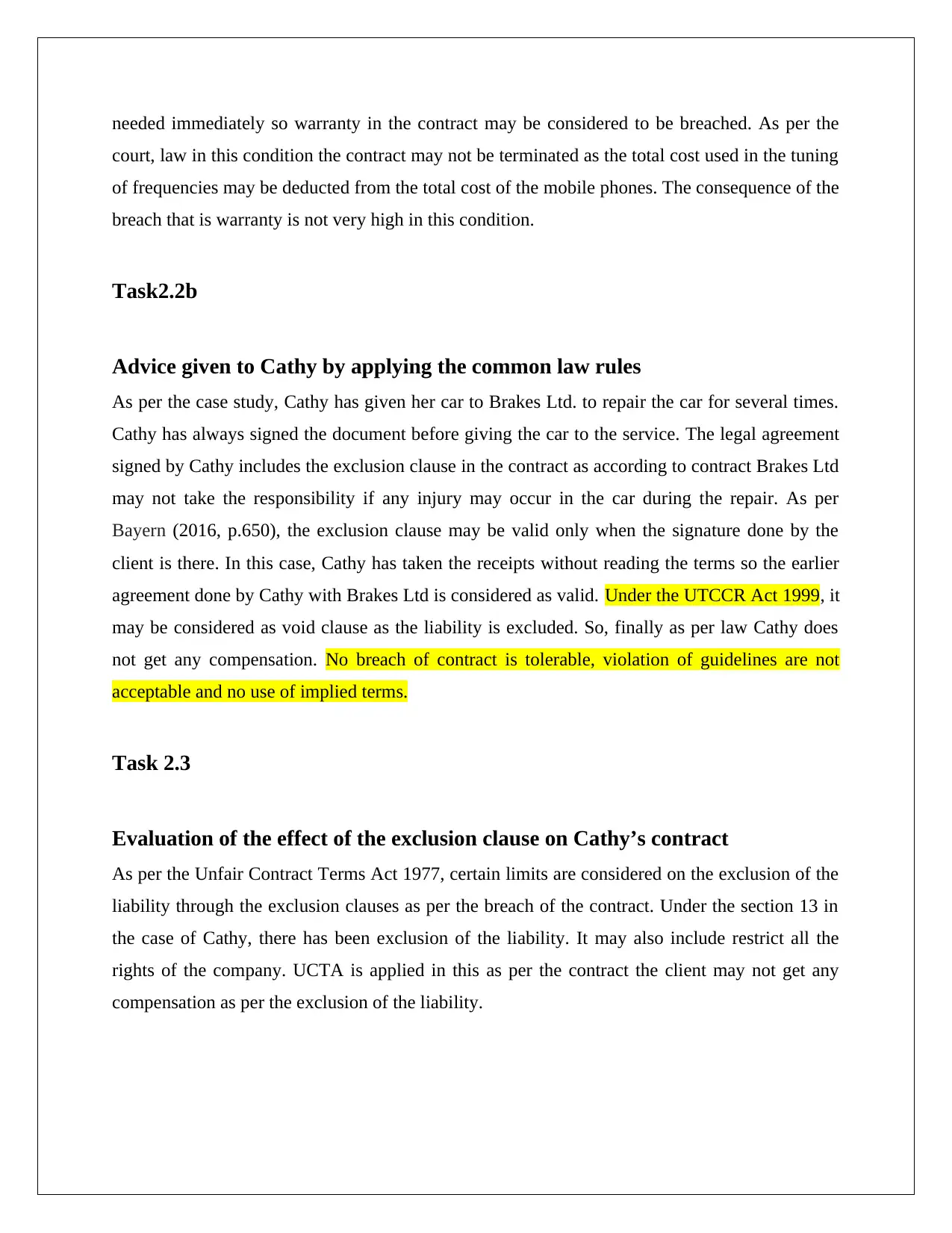
needed immediately so warranty in the contract may be considered to be breached. As per the
court, law in this condition the contract may not be terminated as the total cost used in the tuning
of frequencies may be deducted from the total cost of the mobile phones. The consequence of the
breach that is warranty is not very high in this condition.
Task2.2b
Advice given to Cathy by applying the common law rules
As per the case study, Cathy has given her car to Brakes Ltd. to repair the car for several times.
Cathy has always signed the document before giving the car to the service. The legal agreement
signed by Cathy includes the exclusion clause in the contract as according to contract Brakes Ltd
may not take the responsibility if any injury may occur in the car during the repair. As per
Bayern (2016, p.650), the exclusion clause may be valid only when the signature done by the
client is there. In this case, Cathy has taken the receipts without reading the terms so the earlier
agreement done by Cathy with Brakes Ltd is considered as valid. Under the UTCCR Act 1999, it
may be considered as void clause as the liability is excluded. So, finally as per law Cathy does
not get any compensation. No breach of contract is tolerable, violation of guidelines are not
acceptable and no use of implied terms.
Task 2.3
Evaluation of the effect of the exclusion clause on Cathy’s contract
As per the Unfair Contract Terms Act 1977, certain limits are considered on the exclusion of the
liability through the exclusion clauses as per the breach of the contract. Under the section 13 in
the case of Cathy, there has been exclusion of the liability. It may also include restrict all the
rights of the company. UCTA is applied in this as per the contract the client may not get any
compensation as per the exclusion of the liability.
court, law in this condition the contract may not be terminated as the total cost used in the tuning
of frequencies may be deducted from the total cost of the mobile phones. The consequence of the
breach that is warranty is not very high in this condition.
Task2.2b
Advice given to Cathy by applying the common law rules
As per the case study, Cathy has given her car to Brakes Ltd. to repair the car for several times.
Cathy has always signed the document before giving the car to the service. The legal agreement
signed by Cathy includes the exclusion clause in the contract as according to contract Brakes Ltd
may not take the responsibility if any injury may occur in the car during the repair. As per
Bayern (2016, p.650), the exclusion clause may be valid only when the signature done by the
client is there. In this case, Cathy has taken the receipts without reading the terms so the earlier
agreement done by Cathy with Brakes Ltd is considered as valid. Under the UTCCR Act 1999, it
may be considered as void clause as the liability is excluded. So, finally as per law Cathy does
not get any compensation. No breach of contract is tolerable, violation of guidelines are not
acceptable and no use of implied terms.
Task 2.3
Evaluation of the effect of the exclusion clause on Cathy’s contract
As per the Unfair Contract Terms Act 1977, certain limits are considered on the exclusion of the
liability through the exclusion clauses as per the breach of the contract. Under the section 13 in
the case of Cathy, there has been exclusion of the liability. It may also include restrict all the
rights of the company. UCTA is applied in this as per the contract the client may not get any
compensation as per the exclusion of the liability.
⊘ This is a preview!⊘
Do you want full access?
Subscribe today to unlock all pages.

Trusted by 1+ million students worldwide
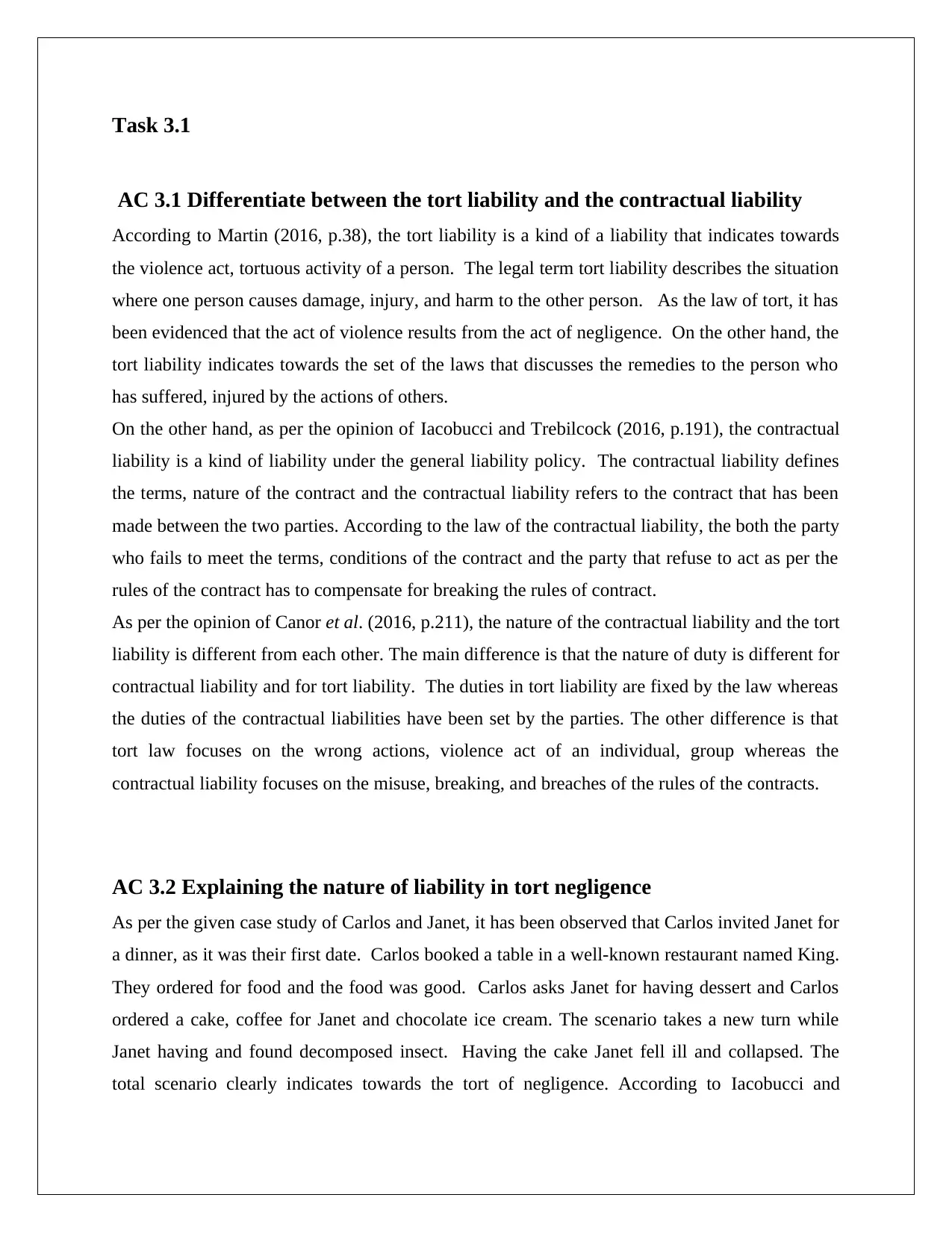
Task 3.1
AC 3.1 Differentiate between the tort liability and the contractual liability
According to Martin (2016, p.38), the tort liability is a kind of a liability that indicates towards
the violence act, tortuous activity of a person. The legal term tort liability describes the situation
where one person causes damage, injury, and harm to the other person. As the law of tort, it has
been evidenced that the act of violence results from the act of negligence. On the other hand, the
tort liability indicates towards the set of the laws that discusses the remedies to the person who
has suffered, injured by the actions of others.
On the other hand, as per the opinion of Iacobucci and Trebilcock (2016, p.191), the contractual
liability is a kind of liability under the general liability policy. The contractual liability defines
the terms, nature of the contract and the contractual liability refers to the contract that has been
made between the two parties. According to the law of the contractual liability, the both the party
who fails to meet the terms, conditions of the contract and the party that refuse to act as per the
rules of the contract has to compensate for breaking the rules of contract.
As per the opinion of Canor et al. (2016, p.211), the nature of the contractual liability and the tort
liability is different from each other. The main difference is that the nature of duty is different for
contractual liability and for tort liability. The duties in tort liability are fixed by the law whereas
the duties of the contractual liabilities have been set by the parties. The other difference is that
tort law focuses on the wrong actions, violence act of an individual, group whereas the
contractual liability focuses on the misuse, breaking, and breaches of the rules of the contracts.
AC 3.2 Explaining the nature of liability in tort negligence
As per the given case study of Carlos and Janet, it has been observed that Carlos invited Janet for
a dinner, as it was their first date. Carlos booked a table in a well-known restaurant named King.
They ordered for food and the food was good. Carlos asks Janet for having dessert and Carlos
ordered a cake, coffee for Janet and chocolate ice cream. The scenario takes a new turn while
Janet having and found decomposed insect. Having the cake Janet fell ill and collapsed. The
total scenario clearly indicates towards the tort of negligence. According to Iacobucci and
AC 3.1 Differentiate between the tort liability and the contractual liability
According to Martin (2016, p.38), the tort liability is a kind of a liability that indicates towards
the violence act, tortuous activity of a person. The legal term tort liability describes the situation
where one person causes damage, injury, and harm to the other person. As the law of tort, it has
been evidenced that the act of violence results from the act of negligence. On the other hand, the
tort liability indicates towards the set of the laws that discusses the remedies to the person who
has suffered, injured by the actions of others.
On the other hand, as per the opinion of Iacobucci and Trebilcock (2016, p.191), the contractual
liability is a kind of liability under the general liability policy. The contractual liability defines
the terms, nature of the contract and the contractual liability refers to the contract that has been
made between the two parties. According to the law of the contractual liability, the both the party
who fails to meet the terms, conditions of the contract and the party that refuse to act as per the
rules of the contract has to compensate for breaking the rules of contract.
As per the opinion of Canor et al. (2016, p.211), the nature of the contractual liability and the tort
liability is different from each other. The main difference is that the nature of duty is different for
contractual liability and for tort liability. The duties in tort liability are fixed by the law whereas
the duties of the contractual liabilities have been set by the parties. The other difference is that
tort law focuses on the wrong actions, violence act of an individual, group whereas the
contractual liability focuses on the misuse, breaking, and breaches of the rules of the contracts.
AC 3.2 Explaining the nature of liability in tort negligence
As per the given case study of Carlos and Janet, it has been observed that Carlos invited Janet for
a dinner, as it was their first date. Carlos booked a table in a well-known restaurant named King.
They ordered for food and the food was good. Carlos asks Janet for having dessert and Carlos
ordered a cake, coffee for Janet and chocolate ice cream. The scenario takes a new turn while
Janet having and found decomposed insect. Having the cake Janet fell ill and collapsed. The
total scenario clearly indicates towards the tort of negligence. According to Iacobucci and
Paraphrase This Document
Need a fresh take? Get an instant paraphrase of this document with our AI Paraphraser
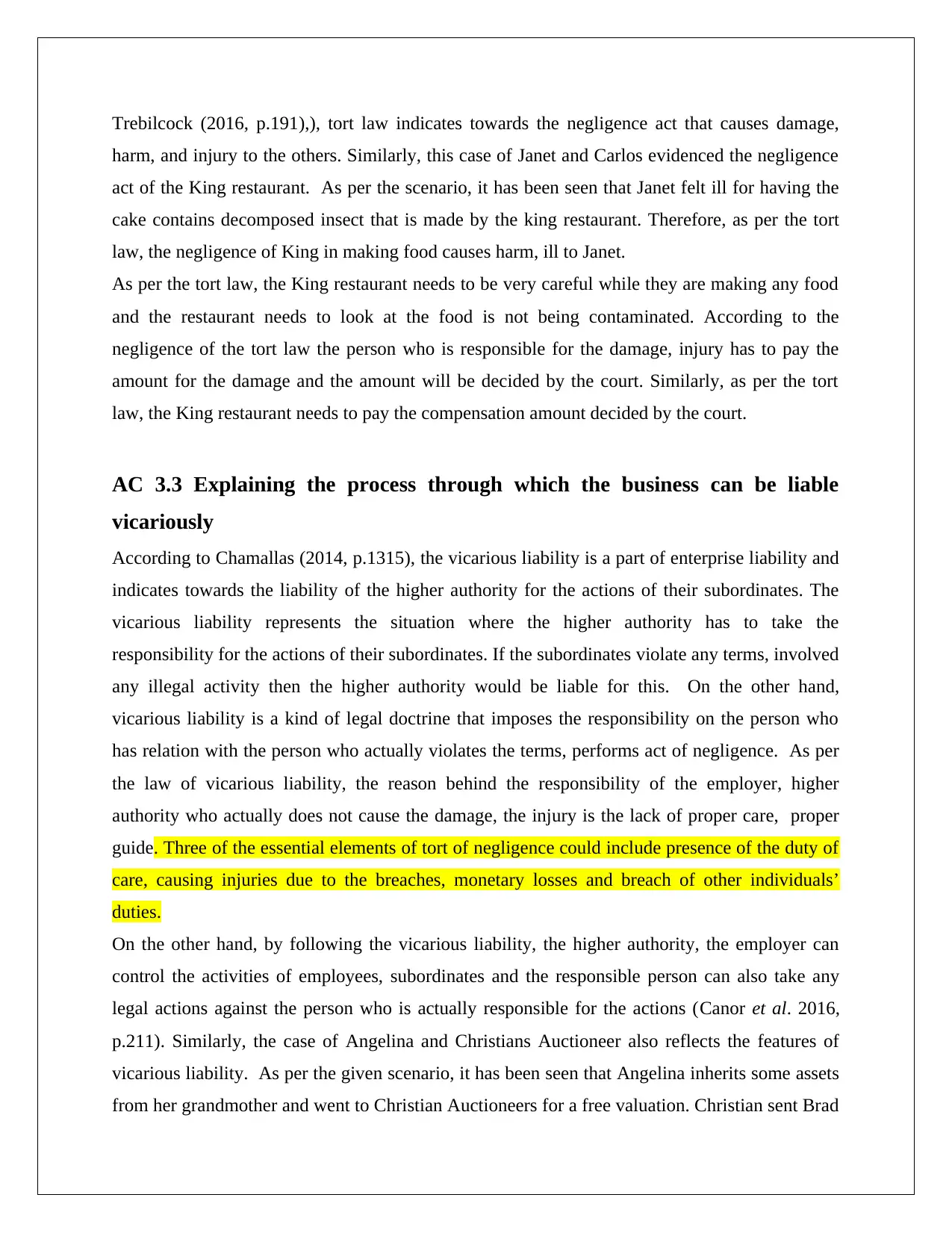
Trebilcock (2016, p.191),), tort law indicates towards the negligence act that causes damage,
harm, and injury to the others. Similarly, this case of Janet and Carlos evidenced the negligence
act of the King restaurant. As per the scenario, it has been seen that Janet felt ill for having the
cake contains decomposed insect that is made by the king restaurant. Therefore, as per the tort
law, the negligence of King in making food causes harm, ill to Janet.
As per the tort law, the King restaurant needs to be very careful while they are making any food
and the restaurant needs to look at the food is not being contaminated. According to the
negligence of the tort law the person who is responsible for the damage, injury has to pay the
amount for the damage and the amount will be decided by the court. Similarly, as per the tort
law, the King restaurant needs to pay the compensation amount decided by the court.
AC 3.3 Explaining the process through which the business can be liable
vicariously
According to Chamallas (2014, p.1315), the vicarious liability is a part of enterprise liability and
indicates towards the liability of the higher authority for the actions of their subordinates. The
vicarious liability represents the situation where the higher authority has to take the
responsibility for the actions of their subordinates. If the subordinates violate any terms, involved
any illegal activity then the higher authority would be liable for this. On the other hand,
vicarious liability is a kind of legal doctrine that imposes the responsibility on the person who
has relation with the person who actually violates the terms, performs act of negligence. As per
the law of vicarious liability, the reason behind the responsibility of the employer, higher
authority who actually does not cause the damage, the injury is the lack of proper care, proper
guide. Three of the essential elements of tort of negligence could include presence of the duty of
care, causing injuries due to the breaches, monetary losses and breach of other individuals’
duties.
On the other hand, by following the vicarious liability, the higher authority, the employer can
control the activities of employees, subordinates and the responsible person can also take any
legal actions against the person who is actually responsible for the actions (Canor et al. 2016,
p.211). Similarly, the case of Angelina and Christians Auctioneer also reflects the features of
vicarious liability. As per the given scenario, it has been seen that Angelina inherits some assets
from her grandmother and went to Christian Auctioneers for a free valuation. Christian sent Brad
harm, and injury to the others. Similarly, this case of Janet and Carlos evidenced the negligence
act of the King restaurant. As per the scenario, it has been seen that Janet felt ill for having the
cake contains decomposed insect that is made by the king restaurant. Therefore, as per the tort
law, the negligence of King in making food causes harm, ill to Janet.
As per the tort law, the King restaurant needs to be very careful while they are making any food
and the restaurant needs to look at the food is not being contaminated. According to the
negligence of the tort law the person who is responsible for the damage, injury has to pay the
amount for the damage and the amount will be decided by the court. Similarly, as per the tort
law, the King restaurant needs to pay the compensation amount decided by the court.
AC 3.3 Explaining the process through which the business can be liable
vicariously
According to Chamallas (2014, p.1315), the vicarious liability is a part of enterprise liability and
indicates towards the liability of the higher authority for the actions of their subordinates. The
vicarious liability represents the situation where the higher authority has to take the
responsibility for the actions of their subordinates. If the subordinates violate any terms, involved
any illegal activity then the higher authority would be liable for this. On the other hand,
vicarious liability is a kind of legal doctrine that imposes the responsibility on the person who
has relation with the person who actually violates the terms, performs act of negligence. As per
the law of vicarious liability, the reason behind the responsibility of the employer, higher
authority who actually does not cause the damage, the injury is the lack of proper care, proper
guide. Three of the essential elements of tort of negligence could include presence of the duty of
care, causing injuries due to the breaches, monetary losses and breach of other individuals’
duties.
On the other hand, by following the vicarious liability, the higher authority, the employer can
control the activities of employees, subordinates and the responsible person can also take any
legal actions against the person who is actually responsible for the actions (Canor et al. 2016,
p.211). Similarly, the case of Angelina and Christians Auctioneer also reflects the features of
vicarious liability. As per the given scenario, it has been seen that Angelina inherits some assets
from her grandmother and went to Christian Auctioneers for a free valuation. Christian sent Brad
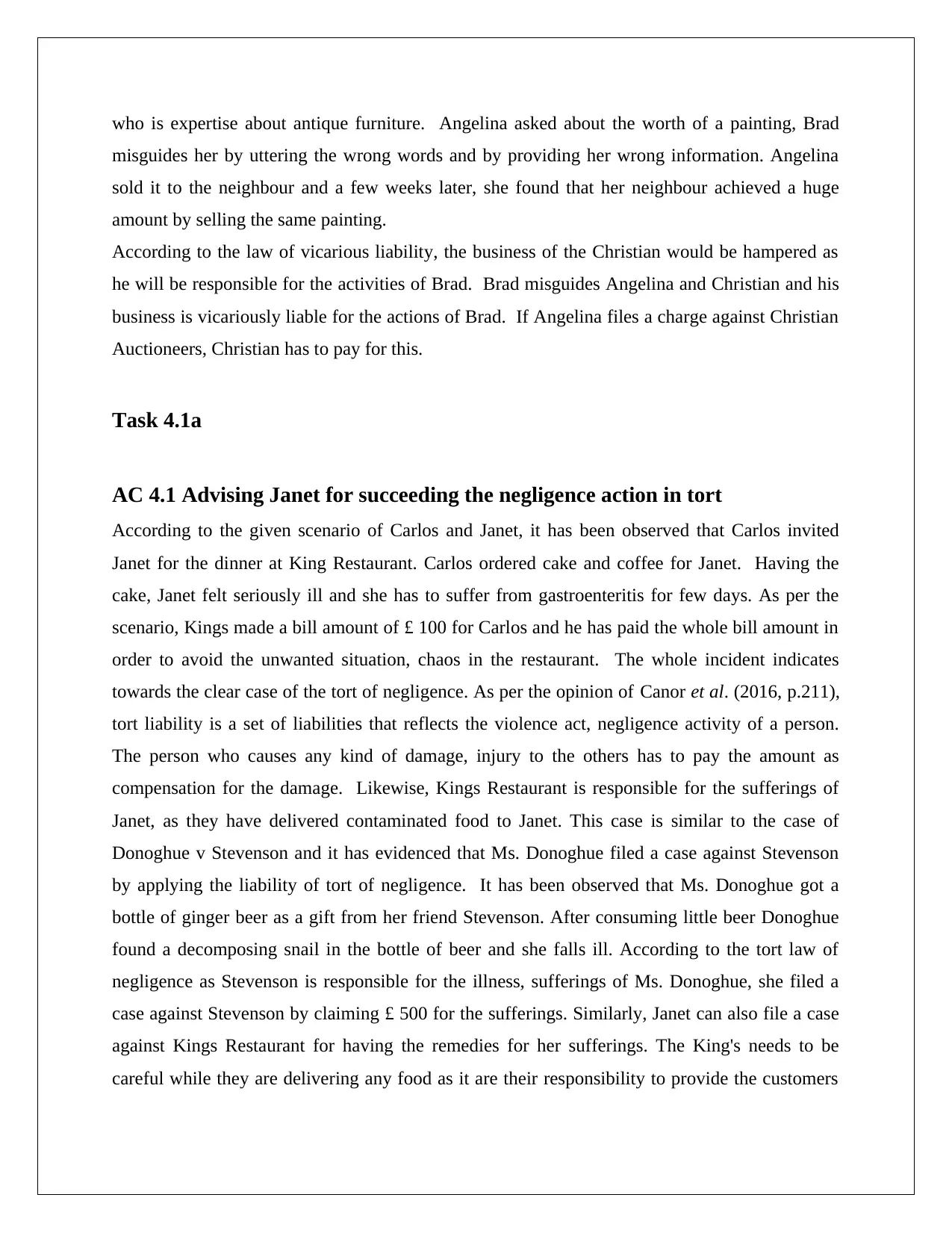
who is expertise about antique furniture. Angelina asked about the worth of a painting, Brad
misguides her by uttering the wrong words and by providing her wrong information. Angelina
sold it to the neighbour and a few weeks later, she found that her neighbour achieved a huge
amount by selling the same painting.
According to the law of vicarious liability, the business of the Christian would be hampered as
he will be responsible for the activities of Brad. Brad misguides Angelina and Christian and his
business is vicariously liable for the actions of Brad. If Angelina files a charge against Christian
Auctioneers, Christian has to pay for this.
Task 4.1a
AC 4.1 Advising Janet for succeeding the negligence action in tort
According to the given scenario of Carlos and Janet, it has been observed that Carlos invited
Janet for the dinner at King Restaurant. Carlos ordered cake and coffee for Janet. Having the
cake, Janet felt seriously ill and she has to suffer from gastroenteritis for few days. As per the
scenario, Kings made a bill amount of £ 100 for Carlos and he has paid the whole bill amount in
order to avoid the unwanted situation, chaos in the restaurant. The whole incident indicates
towards the clear case of the tort of negligence. As per the opinion of Canor et al. (2016, p.211),
tort liability is a set of liabilities that reflects the violence act, negligence activity of a person.
The person who causes any kind of damage, injury to the others has to pay the amount as
compensation for the damage. Likewise, Kings Restaurant is responsible for the sufferings of
Janet, as they have delivered contaminated food to Janet. This case is similar to the case of
Donoghue v Stevenson and it has evidenced that Ms. Donoghue filed a case against Stevenson
by applying the liability of tort of negligence. It has been observed that Ms. Donoghue got a
bottle of ginger beer as a gift from her friend Stevenson. After consuming little beer Donoghue
found a decomposing snail in the bottle of beer and she falls ill. According to the tort law of
negligence as Stevenson is responsible for the illness, sufferings of Ms. Donoghue, she filed a
case against Stevenson by claiming £ 500 for the sufferings. Similarly, Janet can also file a case
against Kings Restaurant for having the remedies for her sufferings. The King's needs to be
careful while they are delivering any food as it are their responsibility to provide the customers
misguides her by uttering the wrong words and by providing her wrong information. Angelina
sold it to the neighbour and a few weeks later, she found that her neighbour achieved a huge
amount by selling the same painting.
According to the law of vicarious liability, the business of the Christian would be hampered as
he will be responsible for the activities of Brad. Brad misguides Angelina and Christian and his
business is vicariously liable for the actions of Brad. If Angelina files a charge against Christian
Auctioneers, Christian has to pay for this.
Task 4.1a
AC 4.1 Advising Janet for succeeding the negligence action in tort
According to the given scenario of Carlos and Janet, it has been observed that Carlos invited
Janet for the dinner at King Restaurant. Carlos ordered cake and coffee for Janet. Having the
cake, Janet felt seriously ill and she has to suffer from gastroenteritis for few days. As per the
scenario, Kings made a bill amount of £ 100 for Carlos and he has paid the whole bill amount in
order to avoid the unwanted situation, chaos in the restaurant. The whole incident indicates
towards the clear case of the tort of negligence. As per the opinion of Canor et al. (2016, p.211),
tort liability is a set of liabilities that reflects the violence act, negligence activity of a person.
The person who causes any kind of damage, injury to the others has to pay the amount as
compensation for the damage. Likewise, Kings Restaurant is responsible for the sufferings of
Janet, as they have delivered contaminated food to Janet. This case is similar to the case of
Donoghue v Stevenson and it has evidenced that Ms. Donoghue filed a case against Stevenson
by applying the liability of tort of negligence. It has been observed that Ms. Donoghue got a
bottle of ginger beer as a gift from her friend Stevenson. After consuming little beer Donoghue
found a decomposing snail in the bottle of beer and she falls ill. According to the tort law of
negligence as Stevenson is responsible for the illness, sufferings of Ms. Donoghue, she filed a
case against Stevenson by claiming £ 500 for the sufferings. Similarly, Janet can also file a case
against Kings Restaurant for having the remedies for her sufferings. The King's needs to be
careful while they are delivering any food as it are their responsibility to provide the customers
⊘ This is a preview!⊘
Do you want full access?
Subscribe today to unlock all pages.

Trusted by 1+ million students worldwide
1 out of 17
Related Documents
Your All-in-One AI-Powered Toolkit for Academic Success.
+13062052269
info@desklib.com
Available 24*7 on WhatsApp / Email
![[object Object]](/_next/static/media/star-bottom.7253800d.svg)
Unlock your academic potential
Copyright © 2020–2025 A2Z Services. All Rights Reserved. Developed and managed by ZUCOL.





